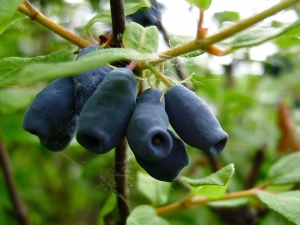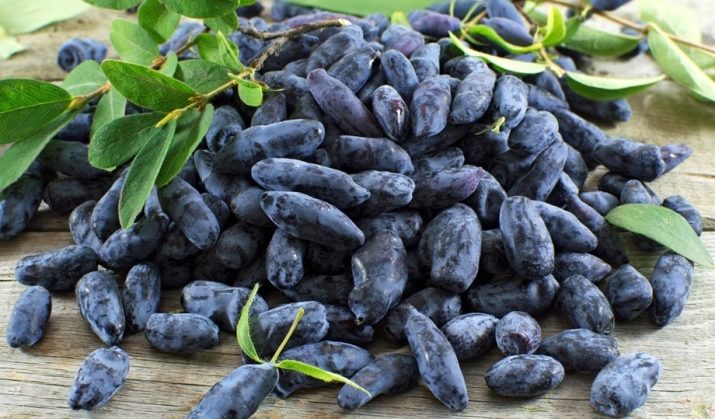Honeysuckle "Amphora": description, planting and care

Today, honeysuckle can be found on many summer cottages.Especially popular among domestic gardeners is the Amphora variety, which was bred specifically for growing in the middle zone of our country. Its berries contain a lot of nutrients, and the plant itself is unpretentious in the care.
Special features
Honeysuckle was very common only 10-15 years ago. Before that, it was relevant in the north of the country, as a wild-growing plant with tasty sweet berries, from which the locals cooked jam or used fresh. Soon she began to appear in local markets and breeders became interested in this plant. In particular, the Amphora variety was bred in St. Petersburg on the basis of wild Kamchatka honeysuckle, at the experimental station VIR im. N.I. Vavilova.
First of all, summer residents and gardeners pay attention to this berry, for whom it is important to have a high content of healthy substances in the products they grow. There are so many of them that the combination of these components can increase the efficiency of the immune system and resist many known viruses, such as swine and avian influenza, as well as Ebola.
In addition, the plant has an anti-inflammatory effect. It is often used as a compress for bone diseases, as well as external damage to the skin of a different nature. Calcium, which is part of it, actively strengthens the structure of bones. That is why the berry is especially useful for children, whose skeleton is just being formed, as well as for the elderly.
Honeysuckle positively affects the organs of vision and respiration, strengthens the cardiovascular system. Her extract is often prescribed by specialists as an additional source of treatment for many diseases of these organs. Among other things, the berries helps to regenerate and slow down the aging of the skin, as well as reduce blood sugar levels. The curative properties of the berry make it a great helper in the fight against seasonal cold, and the complex of vitamins that it contains positively affects the body of children and pregnant women.
Honeysuckle flowers can have white, blue and pink shades. Honeysuckle berries themselves can be classified into toxic and edible. Do not eat yellow berries. Only blue or purple fruits with a light touch like plum are suitable for use.
The plant attracts gardeners not only for its rich composition of useful elements, but also unpretentiousness in cultivation and care.
The grade "Amphora" is distinguished by high frost resistance and pleases its owners with a high degree of productivity and fecundity.
Variety description
Bush variety "Amphora" is characterized by low height - up to 1.5 meters. It will not occupy much space on the site and due to its neat and interesting shape it can become not only a source of wholesome food, but also an element of decorative garden decoration. The crown of the plant has a rounded shape, the branches only slightly branch off from the main powerful trunk and reach for the sky. The branches themselves have a crimson-brown color, which creates an interesting contrast with light green small leaves. They have an elongated oval shape and a smooth surface.
Honeysuckle variety "Amphora" is considered early maturing. The plant begins to give fruit, 3 years after planting. The berries begin to ripen in May, and you can pick them at the end of June. The fruits have the shape of a bell and a rather large size - 2-3 cm. The skin, like the pulp, is dense, has a pronounced blue-violet hue. The taste is bright, sweet, sweet with sourness and hints of bitterness.
The berries ripen together and do not crumble. With one bush on average, you can collect up to 1.5 kg of honeysuckle. The fruits of this plant are actively used for making jam, jam, jelly. Especially this variety is recommended by experienced gardeners for conservation.
Advantages and disadvantages
The main characteristics of the variety include the following characteristics.
- The high content of nutrients in the composition of the berries, which have a beneficial effect on the human body.
- Unpretentiousness in growing and care, as well as good adaptability of the variety to the climatic conditions. Ideal for growing as novice and experienced gardeners.
- Resistance to diseases. Shrubs are rarely exposed to any diseases, but they must be protected from pests that may be of interest to the leaves of the plant.
- Not subject to secondary flowering.
- Dessert taste will interest all family members, including the most capricious in eating children. From the honeysuckle variety "Amphora" get very tasty desserts.
- High degree of storage and excellent ability to transport. This variety is most often used by farmers-entrepreneurs for selling honeysuckle for sale. And lovers can safely store berries in the refrigerator for a long time, without fear of reducing the quality of the product.
The most pronounced disadvantage of the Amphora variety is that it is self-fruitless and needs pollination.
However, this is not so difficult and does not take much time, and then you can get a high-quality and sweet harvest.
Growing techniques and gardeners reviews
Planting seedlings should be carried out in the period from late summer to mid-autumn. It is necessary to take care of the selection of a suitable place. Despite the fact that this variety is unpretentious, you need to take care of its comfort to obtain the highest possible yield. Honeysuckle suited sunlit place devoid of drafts. The soil should be fertile with low alkali content.
Since the variety is self-infertile, it should be planted next to plants of other varieties of honeysuckle. Officially, the following varieties of berries are attributed to its pollinators: Bakcharskaya, Azure, Nymph, Pavlovskaya, Gidzyuk's memory.
Before planting, you need to dig a hole of the same size with the root system of the seedling. Its bottom must be laid out with drainage and fertilized with organic or mineral additives, ashes. Pour the water and place the seedling in the hole.
While Amphora’s honeysuckle is growing, it needs to be watered regularly, but moderately - the ground should be a bit crumbly. This plant does not like excess moisture. After three years, the plant can begin to feed in the period of its intensive growth with the help of specialized solutions, and also do not forget to process from parasites.
Pruning should be done in September 3-4 years after planting. This procedure is performed every 2 years. In the process, dry or damaged branches, as well as those that do not yield, are removed. This must be done in order to prevent the development of plant diseases. After 15 years, experienced gardeners recommend fully rejuvenate the plant.
Honeysuckle can grow in one place for up to 20 years. Transplantation can be carried out at any age, since the bush of the "Amphora" variety will perfectly adapt to the new place.
When the bush begins to produce its first crops, it is often not necessary to water it. The procedure will need to be carried out before the ripening of the berries and after their collection, as well as if necessary, for example, during a long drought. Particular attention should be paid to the bushes in wet, rainy weather, when the plant is particularly susceptible to the spread of disease and pests. It is also necessary to carry out the prevention of fungal infections in time.
Domestic gardeners usually plant amphora bushes, when one of its pollinating varieties is already growing on their summer cottage.
Honeysuckle attracts them with large-sized dessert berries, which is ideal for further preservation and transportation over long distances.
In addition, many gardeners emit a special appearance of the plant - the bushes are neat, rounded, the leaves look very interesting. Shrubs of honeysuckle "Amphora" are great for decorating the garden, so many gardeners use them for this very purpose.
Growing varieties "Amphora" for most gardeners, including beginners, is quite successful, without unpleasant surprises. Unpretentiousness of the plant and resistance to most diseases and pests make this berry the favorite of most gardeners. With regular prevention of parasites and some diseases, the bushes give high yields: summer residents manage to collect up to 1.5-2 kg of berries from one bush. A bright and sweet taste of honeysuckle of this variety will be a real decoration of many desserts.
Read more about honeysuckle variety "Amphora" You will learn from the following video.





























